Management Accounting Report: Financial Analysis for TESCO Retail
VerifiedAdded on 2020/11/23
|18
|5762
|387
Report
AI Summary
This report offers a comprehensive analysis of management accounting principles applied to TESCO, a major player in the retail industry. The report begins with an introduction to management accounting, outlining its core functions and distinguishing it from financial accounting. It explores various types of management accounting systems, such as price optimization, cost accounting, job costing, and inventory management, and their importance in making informed business decisions. The report then delves into different management accounting reports, including performance reports, accounts receivable reports, and sales reports, highlighting their significance in forecasting, decision-making, and variance analysis. Furthermore, it provides a detailed calculation of costs using marginal and absorption costing techniques to prepare an income statement, offering practical insights into cost analysis. Finally, the report covers the advantages and disadvantages of planning tools used for budgetary control and includes a comparison of TESCO with other organizations in response to financial problems.
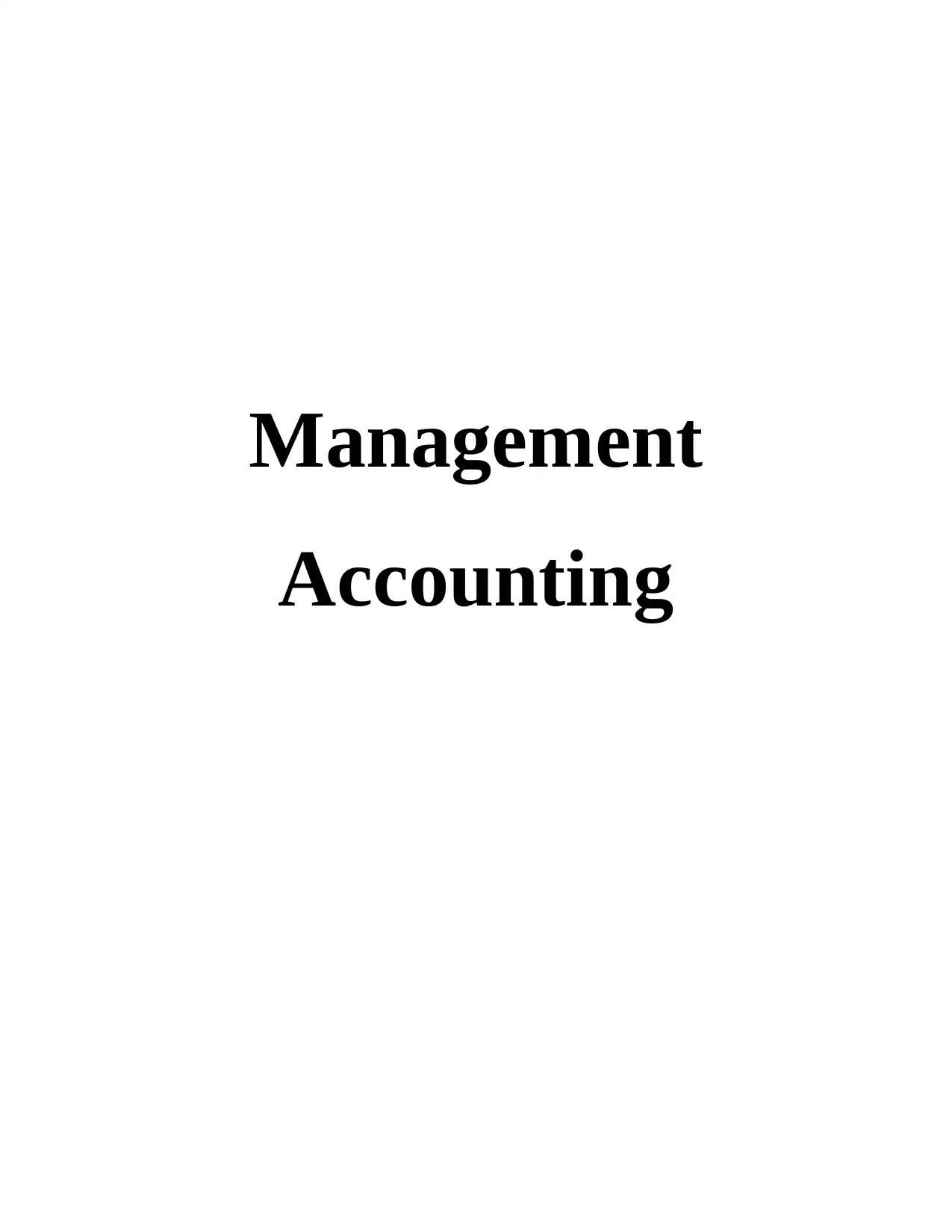
Management
Accounting
Accounting
Paraphrase This Document
Need a fresh take? Get an instant paraphrase of this document with our AI Paraphraser
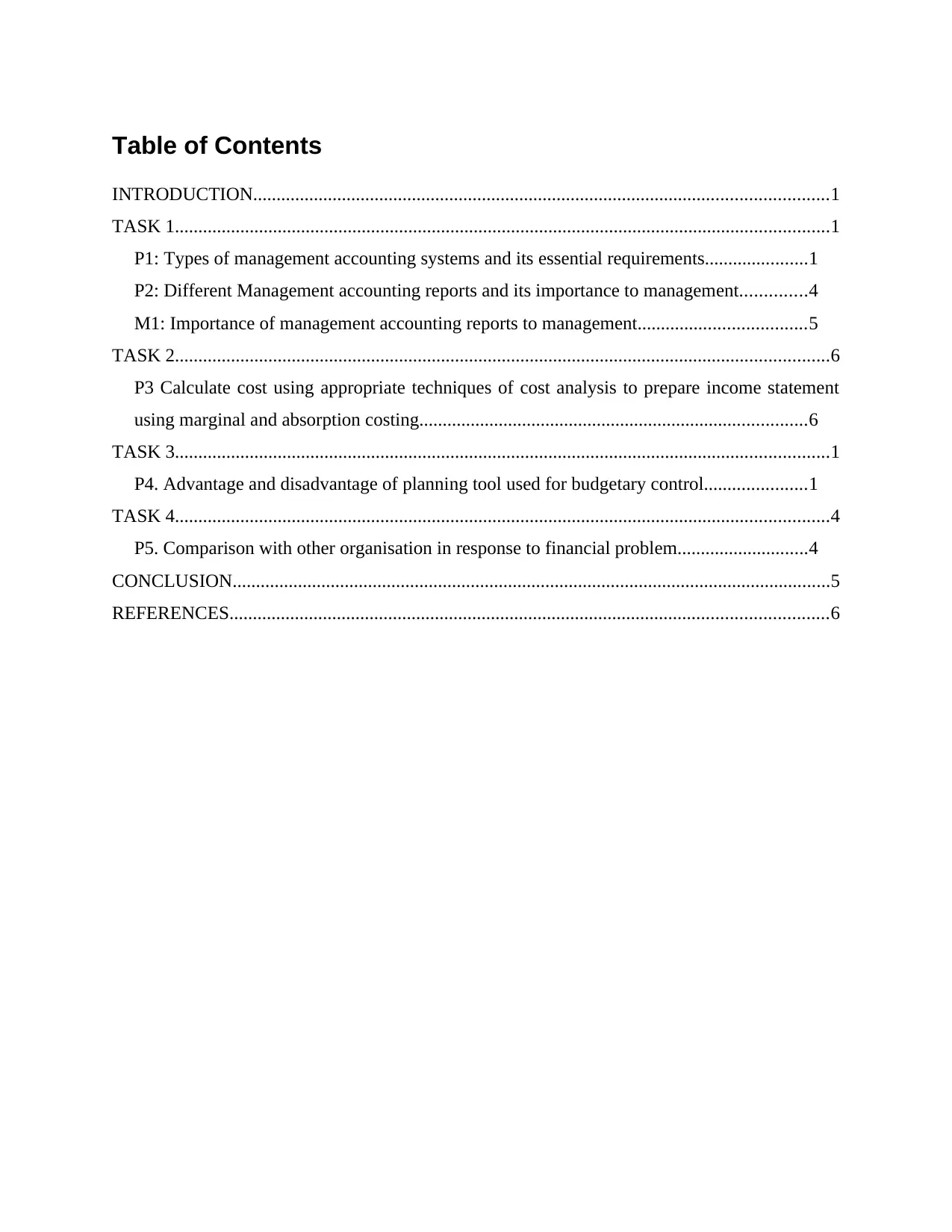
Table of Contents
INTRODUCTION...........................................................................................................................1
TASK 1............................................................................................................................................1
P1: Types of management accounting systems and its essential requirements......................1
P2: Different Management accounting reports and its importance to management..............4
M1: Importance of management accounting reports to management....................................5
TASK 2............................................................................................................................................6
P3 Calculate cost using appropriate techniques of cost analysis to prepare income statement
using marginal and absorption costing...................................................................................6
TASK 3............................................................................................................................................1
P4. Advantage and disadvantage of planning tool used for budgetary control......................1
TASK 4............................................................................................................................................4
P5. Comparison with other organisation in response to financial problem............................4
CONCLUSION................................................................................................................................5
REFERENCES................................................................................................................................6
INTRODUCTION...........................................................................................................................1
TASK 1............................................................................................................................................1
P1: Types of management accounting systems and its essential requirements......................1
P2: Different Management accounting reports and its importance to management..............4
M1: Importance of management accounting reports to management....................................5
TASK 2............................................................................................................................................6
P3 Calculate cost using appropriate techniques of cost analysis to prepare income statement
using marginal and absorption costing...................................................................................6
TASK 3............................................................................................................................................1
P4. Advantage and disadvantage of planning tool used for budgetary control......................1
TASK 4............................................................................................................................................4
P5. Comparison with other organisation in response to financial problem............................4
CONCLUSION................................................................................................................................5
REFERENCES................................................................................................................................6
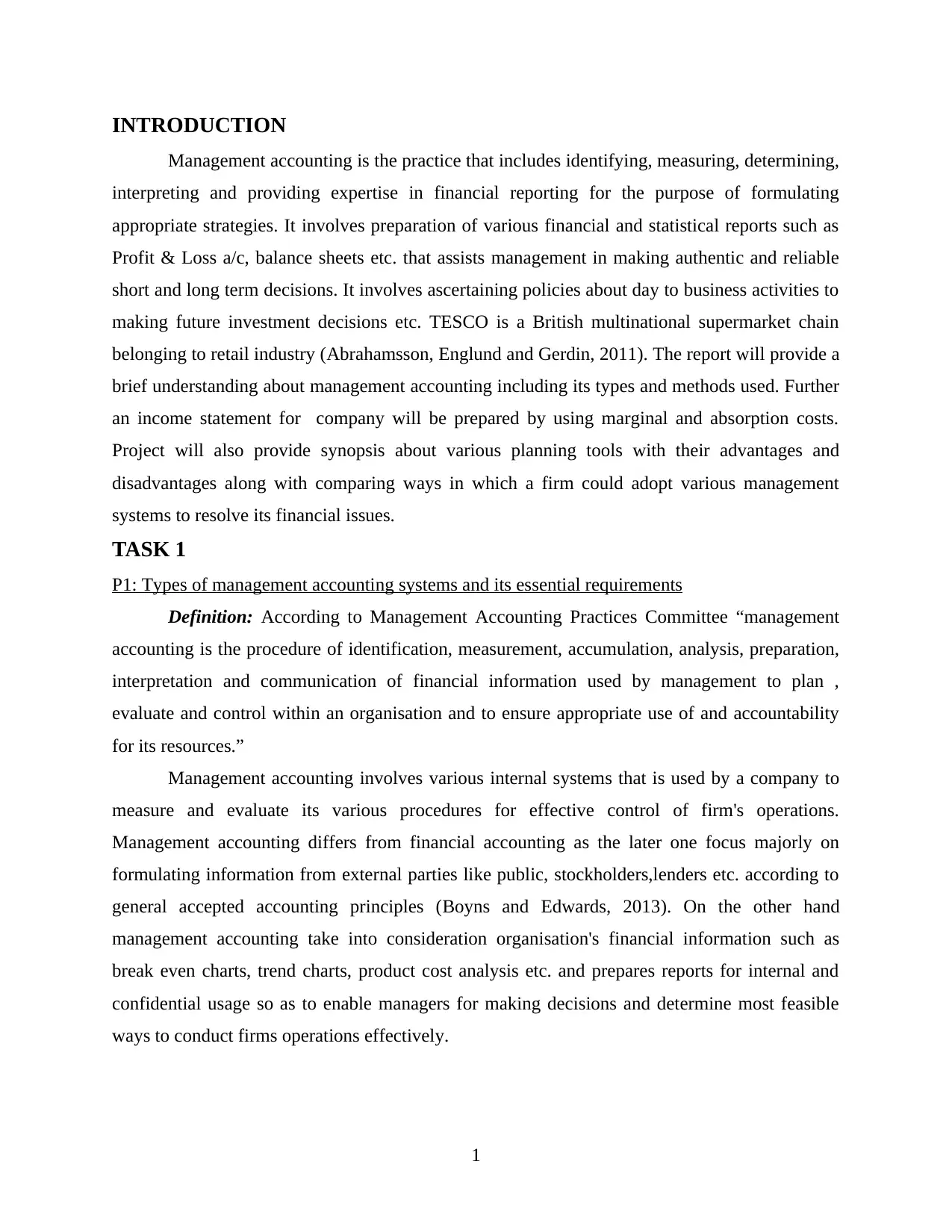
INTRODUCTION
Management accounting is the practice that includes identifying, measuring, determining,
interpreting and providing expertise in financial reporting for the purpose of formulating
appropriate strategies. It involves preparation of various financial and statistical reports such as
Profit & Loss a/c, balance sheets etc. that assists management in making authentic and reliable
short and long term decisions. It involves ascertaining policies about day to business activities to
making future investment decisions etc. TESCO is a British multinational supermarket chain
belonging to retail industry (Abrahamsson, Englund and Gerdin, 2011). The report will provide a
brief understanding about management accounting including its types and methods used. Further
an income statement for company will be prepared by using marginal and absorption costs.
Project will also provide synopsis about various planning tools with their advantages and
disadvantages along with comparing ways in which a firm could adopt various management
systems to resolve its financial issues.
TASK 1
P1: Types of management accounting systems and its essential requirements
Definition: According to Management Accounting Practices Committee “management
accounting is the procedure of identification, measurement, accumulation, analysis, preparation,
interpretation and communication of financial information used by management to plan ,
evaluate and control within an organisation and to ensure appropriate use of and accountability
for its resources.”
Management accounting involves various internal systems that is used by a company to
measure and evaluate its various procedures for effective control of firm's operations.
Management accounting differs from financial accounting as the later one focus majorly on
formulating information from external parties like public, stockholders,lenders etc. according to
general accepted accounting principles (Boyns and Edwards, 2013). On the other hand
management accounting take into consideration organisation's financial information such as
break even charts, trend charts, product cost analysis etc. and prepares reports for internal and
confidential usage so as to enable managers for making decisions and determine most feasible
ways to conduct firms operations effectively.
1
Management accounting is the practice that includes identifying, measuring, determining,
interpreting and providing expertise in financial reporting for the purpose of formulating
appropriate strategies. It involves preparation of various financial and statistical reports such as
Profit & Loss a/c, balance sheets etc. that assists management in making authentic and reliable
short and long term decisions. It involves ascertaining policies about day to business activities to
making future investment decisions etc. TESCO is a British multinational supermarket chain
belonging to retail industry (Abrahamsson, Englund and Gerdin, 2011). The report will provide a
brief understanding about management accounting including its types and methods used. Further
an income statement for company will be prepared by using marginal and absorption costs.
Project will also provide synopsis about various planning tools with their advantages and
disadvantages along with comparing ways in which a firm could adopt various management
systems to resolve its financial issues.
TASK 1
P1: Types of management accounting systems and its essential requirements
Definition: According to Management Accounting Practices Committee “management
accounting is the procedure of identification, measurement, accumulation, analysis, preparation,
interpretation and communication of financial information used by management to plan ,
evaluate and control within an organisation and to ensure appropriate use of and accountability
for its resources.”
Management accounting involves various internal systems that is used by a company to
measure and evaluate its various procedures for effective control of firm's operations.
Management accounting differs from financial accounting as the later one focus majorly on
formulating information from external parties like public, stockholders,lenders etc. according to
general accepted accounting principles (Boyns and Edwards, 2013). On the other hand
management accounting take into consideration organisation's financial information such as
break even charts, trend charts, product cost analysis etc. and prepares reports for internal and
confidential usage so as to enable managers for making decisions and determine most feasible
ways to conduct firms operations effectively.
1
⊘ This is a preview!⊘
Do you want full access?
Subscribe today to unlock all pages.

Trusted by 1+ million students worldwide
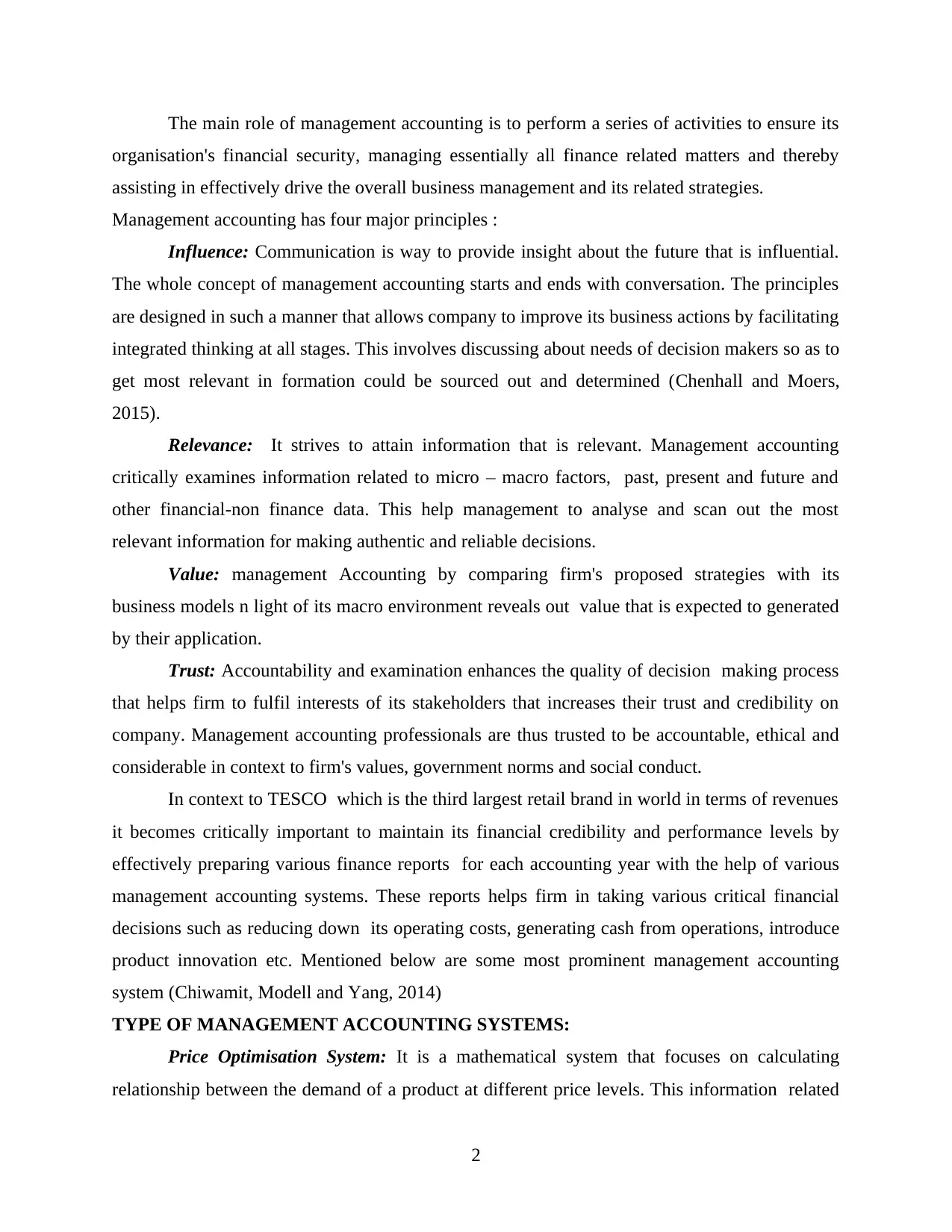
The main role of management accounting is to perform a series of activities to ensure its
organisation's financial security, managing essentially all finance related matters and thereby
assisting in effectively drive the overall business management and its related strategies.
Management accounting has four major principles :
Influence: Communication is way to provide insight about the future that is influential.
The whole concept of management accounting starts and ends with conversation. The principles
are designed in such a manner that allows company to improve its business actions by facilitating
integrated thinking at all stages. This involves discussing about needs of decision makers so as to
get most relevant in formation could be sourced out and determined (Chenhall and Moers,
2015).
Relevance: It strives to attain information that is relevant. Management accounting
critically examines information related to micro – macro factors, past, present and future and
other financial-non finance data. This help management to analyse and scan out the most
relevant information for making authentic and reliable decisions.
Value: management Accounting by comparing firm's proposed strategies with its
business models n light of its macro environment reveals out value that is expected to generated
by their application.
Trust: Accountability and examination enhances the quality of decision making process
that helps firm to fulfil interests of its stakeholders that increases their trust and credibility on
company. Management accounting professionals are thus trusted to be accountable, ethical and
considerable in context to firm's values, government norms and social conduct.
In context to TESCO which is the third largest retail brand in world in terms of revenues
it becomes critically important to maintain its financial credibility and performance levels by
effectively preparing various finance reports for each accounting year with the help of various
management accounting systems. These reports helps firm in taking various critical financial
decisions such as reducing down its operating costs, generating cash from operations, introduce
product innovation etc. Mentioned below are some most prominent management accounting
system (Chiwamit, Modell and Yang, 2014)
TYPE OF MANAGEMENT ACCOUNTING SYSTEMS:
Price Optimisation System: It is a mathematical system that focuses on calculating
relationship between the demand of a product at different price levels. This information related
2
organisation's financial security, managing essentially all finance related matters and thereby
assisting in effectively drive the overall business management and its related strategies.
Management accounting has four major principles :
Influence: Communication is way to provide insight about the future that is influential.
The whole concept of management accounting starts and ends with conversation. The principles
are designed in such a manner that allows company to improve its business actions by facilitating
integrated thinking at all stages. This involves discussing about needs of decision makers so as to
get most relevant in formation could be sourced out and determined (Chenhall and Moers,
2015).
Relevance: It strives to attain information that is relevant. Management accounting
critically examines information related to micro – macro factors, past, present and future and
other financial-non finance data. This help management to analyse and scan out the most
relevant information for making authentic and reliable decisions.
Value: management Accounting by comparing firm's proposed strategies with its
business models n light of its macro environment reveals out value that is expected to generated
by their application.
Trust: Accountability and examination enhances the quality of decision making process
that helps firm to fulfil interests of its stakeholders that increases their trust and credibility on
company. Management accounting professionals are thus trusted to be accountable, ethical and
considerable in context to firm's values, government norms and social conduct.
In context to TESCO which is the third largest retail brand in world in terms of revenues
it becomes critically important to maintain its financial credibility and performance levels by
effectively preparing various finance reports for each accounting year with the help of various
management accounting systems. These reports helps firm in taking various critical financial
decisions such as reducing down its operating costs, generating cash from operations, introduce
product innovation etc. Mentioned below are some most prominent management accounting
system (Chiwamit, Modell and Yang, 2014)
TYPE OF MANAGEMENT ACCOUNTING SYSTEMS:
Price Optimisation System: It is a mathematical system that focuses on calculating
relationship between the demand of a product at different price levels. This information related
2
Paraphrase This Document
Need a fresh take? Get an instant paraphrase of this document with our AI Paraphraser
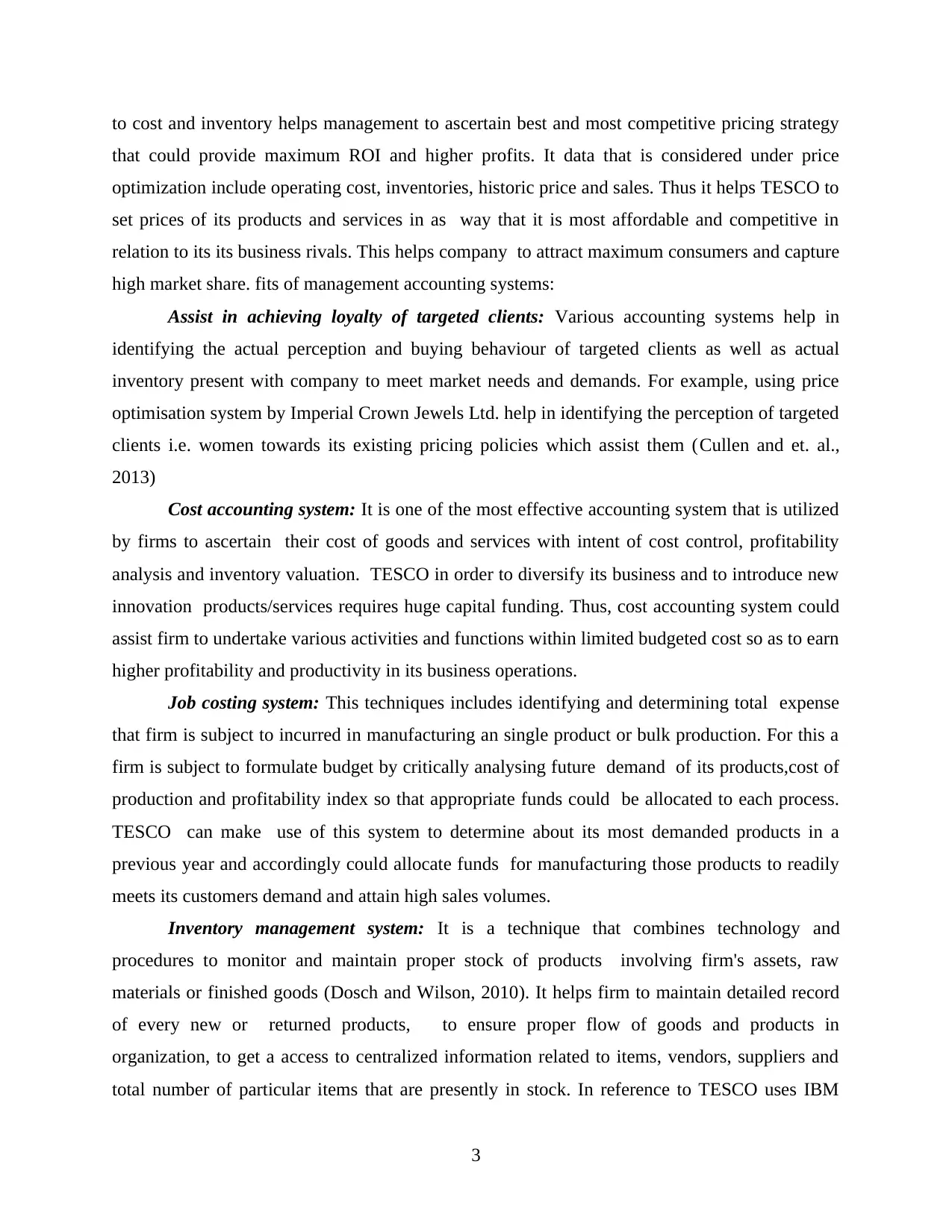
to cost and inventory helps management to ascertain best and most competitive pricing strategy
that could provide maximum ROI and higher profits. It data that is considered under price
optimization include operating cost, inventories, historic price and sales. Thus it helps TESCO to
set prices of its products and services in as way that it is most affordable and competitive in
relation to its its business rivals. This helps company to attract maximum consumers and capture
high market share. fits of management accounting systems:
Assist in achieving loyalty of targeted clients: Various accounting systems help in
identifying the actual perception and buying behaviour of targeted clients as well as actual
inventory present with company to meet market needs and demands. For example, using price
optimisation system by Imperial Crown Jewels Ltd. help in identifying the perception of targeted
clients i.e. women towards its existing pricing policies which assist them (Cullen and et. al.,
2013)
Cost accounting system: It is one of the most effective accounting system that is utilized
by firms to ascertain their cost of goods and services with intent of cost control, profitability
analysis and inventory valuation. TESCO in order to diversify its business and to introduce new
innovation products/services requires huge capital funding. Thus, cost accounting system could
assist firm to undertake various activities and functions within limited budgeted cost so as to earn
higher profitability and productivity in its business operations.
Job costing system: This techniques includes identifying and determining total expense
that firm is subject to incurred in manufacturing an single product or bulk production. For this a
firm is subject to formulate budget by critically analysing future demand of its products,cost of
production and profitability index so that appropriate funds could be allocated to each process.
TESCO can make use of this system to determine about its most demanded products in a
previous year and accordingly could allocate funds for manufacturing those products to readily
meets its customers demand and attain high sales volumes.
Inventory management system: It is a technique that combines technology and
procedures to monitor and maintain proper stock of products involving firm's assets, raw
materials or finished goods (Dosch and Wilson, 2010). It helps firm to maintain detailed record
of every new or returned products, to ensure proper flow of goods and products in
organization, to get a access to centralized information related to items, vendors, suppliers and
total number of particular items that are presently in stock. In reference to TESCO uses IBM
3
that could provide maximum ROI and higher profits. It data that is considered under price
optimization include operating cost, inventories, historic price and sales. Thus it helps TESCO to
set prices of its products and services in as way that it is most affordable and competitive in
relation to its its business rivals. This helps company to attract maximum consumers and capture
high market share. fits of management accounting systems:
Assist in achieving loyalty of targeted clients: Various accounting systems help in
identifying the actual perception and buying behaviour of targeted clients as well as actual
inventory present with company to meet market needs and demands. For example, using price
optimisation system by Imperial Crown Jewels Ltd. help in identifying the perception of targeted
clients i.e. women towards its existing pricing policies which assist them (Cullen and et. al.,
2013)
Cost accounting system: It is one of the most effective accounting system that is utilized
by firms to ascertain their cost of goods and services with intent of cost control, profitability
analysis and inventory valuation. TESCO in order to diversify its business and to introduce new
innovation products/services requires huge capital funding. Thus, cost accounting system could
assist firm to undertake various activities and functions within limited budgeted cost so as to earn
higher profitability and productivity in its business operations.
Job costing system: This techniques includes identifying and determining total expense
that firm is subject to incurred in manufacturing an single product or bulk production. For this a
firm is subject to formulate budget by critically analysing future demand of its products,cost of
production and profitability index so that appropriate funds could be allocated to each process.
TESCO can make use of this system to determine about its most demanded products in a
previous year and accordingly could allocate funds for manufacturing those products to readily
meets its customers demand and attain high sales volumes.
Inventory management system: It is a technique that combines technology and
procedures to monitor and maintain proper stock of products involving firm's assets, raw
materials or finished goods (Dosch and Wilson, 2010). It helps firm to maintain detailed record
of every new or returned products, to ensure proper flow of goods and products in
organization, to get a access to centralized information related to items, vendors, suppliers and
total number of particular items that are presently in stock. In reference to TESCO uses IBM
3
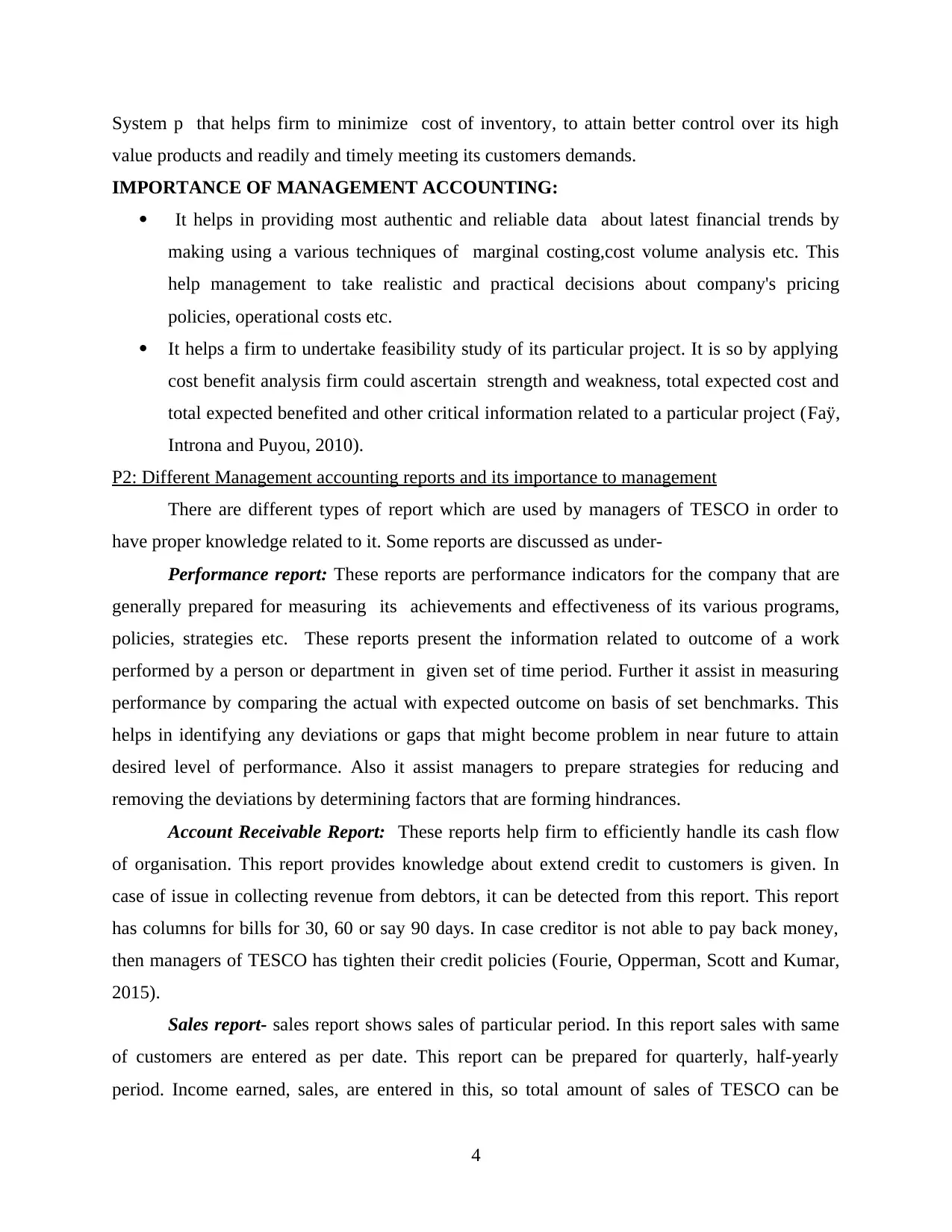
System p that helps firm to minimize cost of inventory, to attain better control over its high
value products and readily and timely meeting its customers demands.
IMPORTANCE OF MANAGEMENT ACCOUNTING:
It helps in providing most authentic and reliable data about latest financial trends by
making using a various techniques of marginal costing,cost volume analysis etc. This
help management to take realistic and practical decisions about company's pricing
policies, operational costs etc.
It helps a firm to undertake feasibility study of its particular project. It is so by applying
cost benefit analysis firm could ascertain strength and weakness, total expected cost and
total expected benefited and other critical information related to a particular project (Faÿ,
Introna and Puyou, 2010).
P2: Different Management accounting reports and its importance to management
There are different types of report which are used by managers of TESCO in order to
have proper knowledge related to it. Some reports are discussed as under-
Performance report: These reports are performance indicators for the company that are
generally prepared for measuring its achievements and effectiveness of its various programs,
policies, strategies etc. These reports present the information related to outcome of a work
performed by a person or department in given set of time period. Further it assist in measuring
performance by comparing the actual with expected outcome on basis of set benchmarks. This
helps in identifying any deviations or gaps that might become problem in near future to attain
desired level of performance. Also it assist managers to prepare strategies for reducing and
removing the deviations by determining factors that are forming hindrances.
Account Receivable Report: These reports help firm to efficiently handle its cash flow
of organisation. This report provides knowledge about extend credit to customers is given. In
case of issue in collecting revenue from debtors, it can be detected from this report. This report
has columns for bills for 30, 60 or say 90 days. In case creditor is not able to pay back money,
then managers of TESCO has tighten their credit policies (Fourie, Opperman, Scott and Kumar,
2015).
Sales report- sales report shows sales of particular period. In this report sales with same
of customers are entered as per date. This report can be prepared for quarterly, half-yearly
period. Income earned, sales, are entered in this, so total amount of sales of TESCO can be
4
value products and readily and timely meeting its customers demands.
IMPORTANCE OF MANAGEMENT ACCOUNTING:
It helps in providing most authentic and reliable data about latest financial trends by
making using a various techniques of marginal costing,cost volume analysis etc. This
help management to take realistic and practical decisions about company's pricing
policies, operational costs etc.
It helps a firm to undertake feasibility study of its particular project. It is so by applying
cost benefit analysis firm could ascertain strength and weakness, total expected cost and
total expected benefited and other critical information related to a particular project (Faÿ,
Introna and Puyou, 2010).
P2: Different Management accounting reports and its importance to management
There are different types of report which are used by managers of TESCO in order to
have proper knowledge related to it. Some reports are discussed as under-
Performance report: These reports are performance indicators for the company that are
generally prepared for measuring its achievements and effectiveness of its various programs,
policies, strategies etc. These reports present the information related to outcome of a work
performed by a person or department in given set of time period. Further it assist in measuring
performance by comparing the actual with expected outcome on basis of set benchmarks. This
helps in identifying any deviations or gaps that might become problem in near future to attain
desired level of performance. Also it assist managers to prepare strategies for reducing and
removing the deviations by determining factors that are forming hindrances.
Account Receivable Report: These reports help firm to efficiently handle its cash flow
of organisation. This report provides knowledge about extend credit to customers is given. In
case of issue in collecting revenue from debtors, it can be detected from this report. This report
has columns for bills for 30, 60 or say 90 days. In case creditor is not able to pay back money,
then managers of TESCO has tighten their credit policies (Fourie, Opperman, Scott and Kumar,
2015).
Sales report- sales report shows sales of particular period. In this report sales with same
of customers are entered as per date. This report can be prepared for quarterly, half-yearly
period. Income earned, sales, are entered in this, so total amount of sales of TESCO can be
4
⊘ This is a preview!⊘
Do you want full access?
Subscribe today to unlock all pages.

Trusted by 1+ million students worldwide
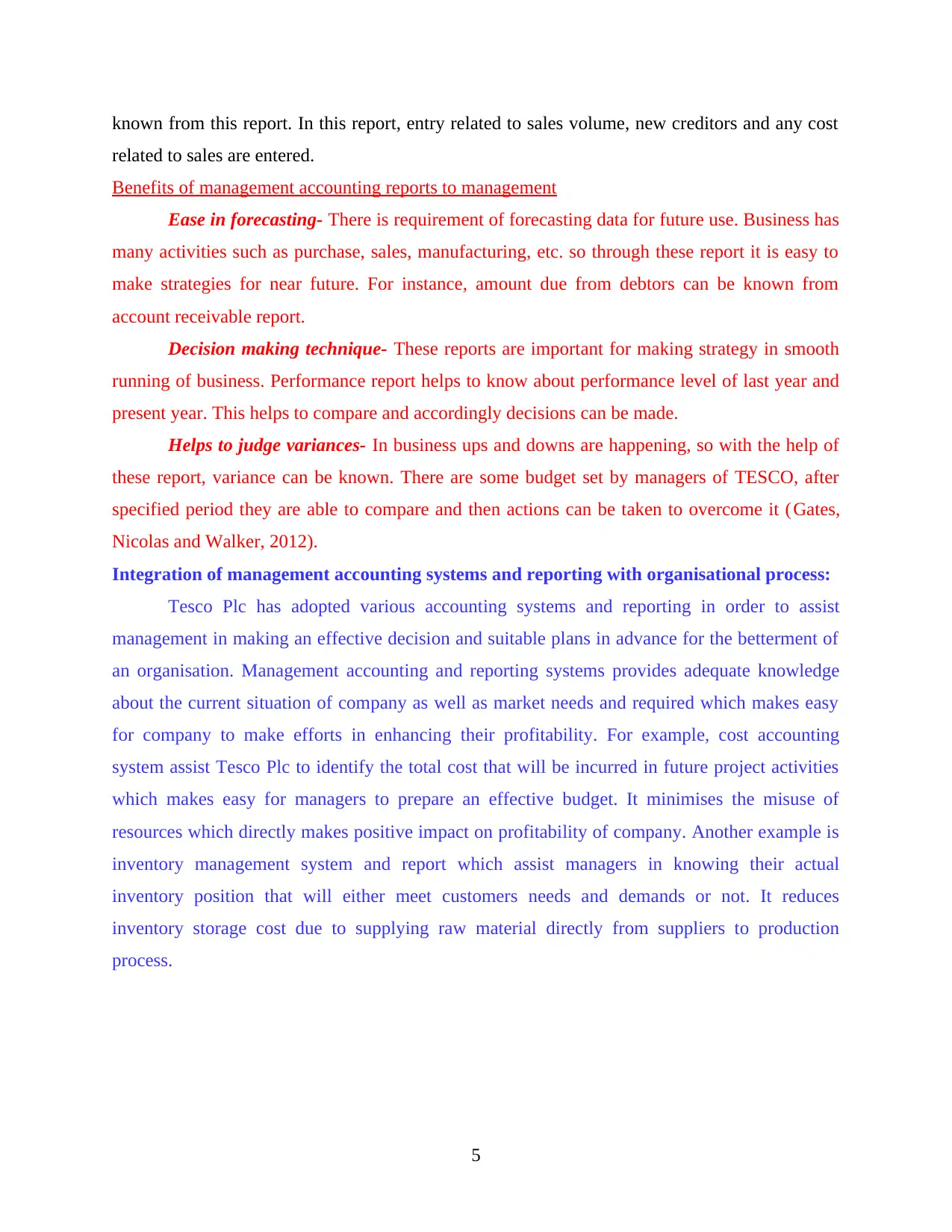
known from this report. In this report, entry related to sales volume, new creditors and any cost
related to sales are entered.
Benefits of management accounting reports to management
Ease in forecasting- There is requirement of forecasting data for future use. Business has
many activities such as purchase, sales, manufacturing, etc. so through these report it is easy to
make strategies for near future. For instance, amount due from debtors can be known from
account receivable report.
Decision making technique- These reports are important for making strategy in smooth
running of business. Performance report helps to know about performance level of last year and
present year. This helps to compare and accordingly decisions can be made.
Helps to judge variances- In business ups and downs are happening, so with the help of
these report, variance can be known. There are some budget set by managers of TESCO, after
specified period they are able to compare and then actions can be taken to overcome it (Gates,
Nicolas and Walker, 2012).
Integration of management accounting systems and reporting with organisational process:
Tesco Plc has adopted various accounting systems and reporting in order to assist
management in making an effective decision and suitable plans in advance for the betterment of
an organisation. Management accounting and reporting systems provides adequate knowledge
about the current situation of company as well as market needs and required which makes easy
for company to make efforts in enhancing their profitability. For example, cost accounting
system assist Tesco Plc to identify the total cost that will be incurred in future project activities
which makes easy for managers to prepare an effective budget. It minimises the misuse of
resources which directly makes positive impact on profitability of company. Another example is
inventory management system and report which assist managers in knowing their actual
inventory position that will either meet customers needs and demands or not. It reduces
inventory storage cost due to supplying raw material directly from suppliers to production
process.
5
related to sales are entered.
Benefits of management accounting reports to management
Ease in forecasting- There is requirement of forecasting data for future use. Business has
many activities such as purchase, sales, manufacturing, etc. so through these report it is easy to
make strategies for near future. For instance, amount due from debtors can be known from
account receivable report.
Decision making technique- These reports are important for making strategy in smooth
running of business. Performance report helps to know about performance level of last year and
present year. This helps to compare and accordingly decisions can be made.
Helps to judge variances- In business ups and downs are happening, so with the help of
these report, variance can be known. There are some budget set by managers of TESCO, after
specified period they are able to compare and then actions can be taken to overcome it (Gates,
Nicolas and Walker, 2012).
Integration of management accounting systems and reporting with organisational process:
Tesco Plc has adopted various accounting systems and reporting in order to assist
management in making an effective decision and suitable plans in advance for the betterment of
an organisation. Management accounting and reporting systems provides adequate knowledge
about the current situation of company as well as market needs and required which makes easy
for company to make efforts in enhancing their profitability. For example, cost accounting
system assist Tesco Plc to identify the total cost that will be incurred in future project activities
which makes easy for managers to prepare an effective budget. It minimises the misuse of
resources which directly makes positive impact on profitability of company. Another example is
inventory management system and report which assist managers in knowing their actual
inventory position that will either meet customers needs and demands or not. It reduces
inventory storage cost due to supplying raw material directly from suppliers to production
process.
5
Paraphrase This Document
Need a fresh take? Get an instant paraphrase of this document with our AI Paraphraser
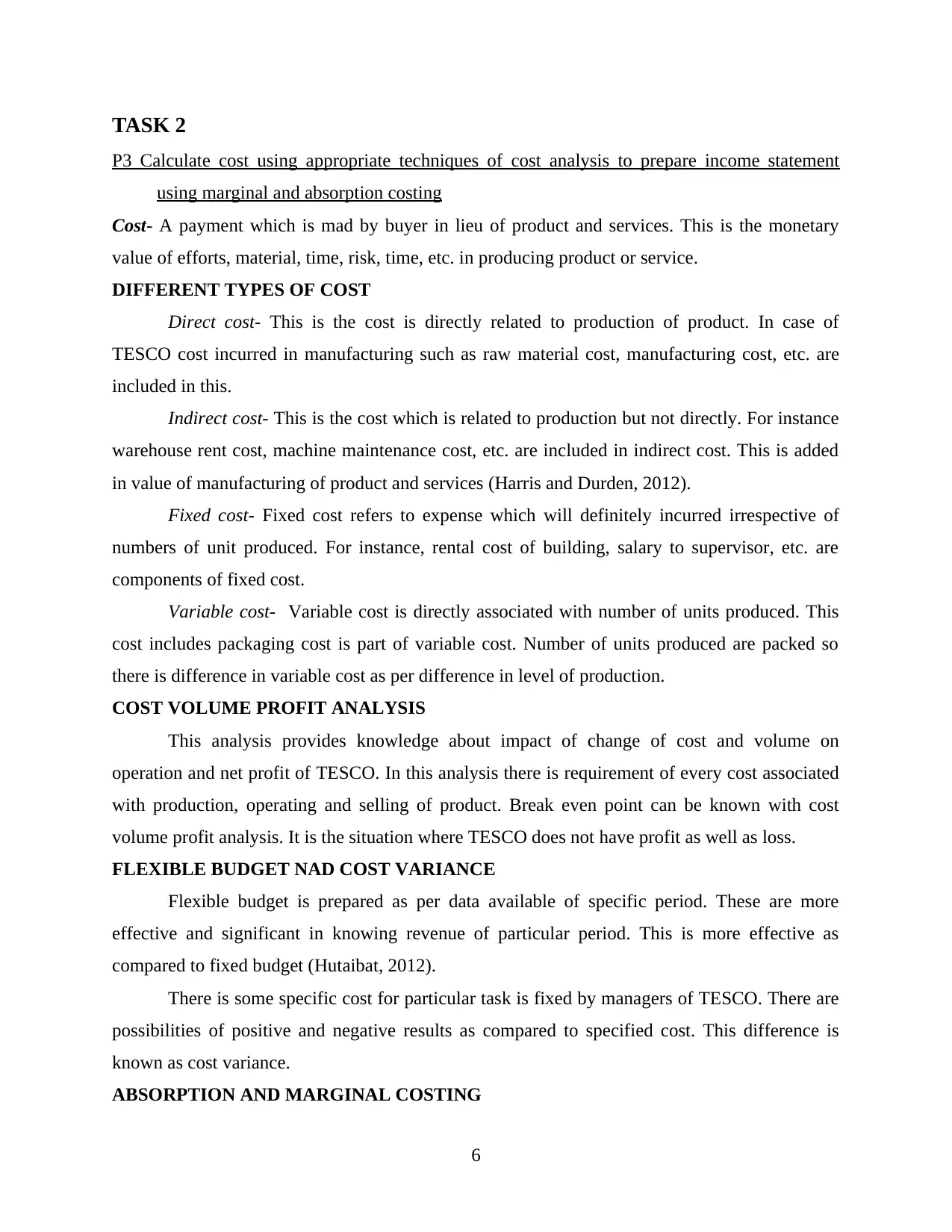
TASK 2
P3 Calculate cost using appropriate techniques of cost analysis to prepare income statement
using marginal and absorption costing
Cost- A payment which is mad by buyer in lieu of product and services. This is the monetary
value of efforts, material, time, risk, time, etc. in producing product or service.
DIFFERENT TYPES OF COST
Direct cost- This is the cost is directly related to production of product. In case of
TESCO cost incurred in manufacturing such as raw material cost, manufacturing cost, etc. are
included in this.
Indirect cost- This is the cost which is related to production but not directly. For instance
warehouse rent cost, machine maintenance cost, etc. are included in indirect cost. This is added
in value of manufacturing of product and services (Harris and Durden, 2012).
Fixed cost- Fixed cost refers to expense which will definitely incurred irrespective of
numbers of unit produced. For instance, rental cost of building, salary to supervisor, etc. are
components of fixed cost.
Variable cost- Variable cost is directly associated with number of units produced. This
cost includes packaging cost is part of variable cost. Number of units produced are packed so
there is difference in variable cost as per difference in level of production.
COST VOLUME PROFIT ANALYSIS
This analysis provides knowledge about impact of change of cost and volume on
operation and net profit of TESCO. In this analysis there is requirement of every cost associated
with production, operating and selling of product. Break even point can be known with cost
volume profit analysis. It is the situation where TESCO does not have profit as well as loss.
FLEXIBLE BUDGET NAD COST VARIANCE
Flexible budget is prepared as per data available of specific period. These are more
effective and significant in knowing revenue of particular period. This is more effective as
compared to fixed budget (Hutaibat, 2012).
There is some specific cost for particular task is fixed by managers of TESCO. There are
possibilities of positive and negative results as compared to specified cost. This difference is
known as cost variance.
ABSORPTION AND MARGINAL COSTING
6
P3 Calculate cost using appropriate techniques of cost analysis to prepare income statement
using marginal and absorption costing
Cost- A payment which is mad by buyer in lieu of product and services. This is the monetary
value of efforts, material, time, risk, time, etc. in producing product or service.
DIFFERENT TYPES OF COST
Direct cost- This is the cost is directly related to production of product. In case of
TESCO cost incurred in manufacturing such as raw material cost, manufacturing cost, etc. are
included in this.
Indirect cost- This is the cost which is related to production but not directly. For instance
warehouse rent cost, machine maintenance cost, etc. are included in indirect cost. This is added
in value of manufacturing of product and services (Harris and Durden, 2012).
Fixed cost- Fixed cost refers to expense which will definitely incurred irrespective of
numbers of unit produced. For instance, rental cost of building, salary to supervisor, etc. are
components of fixed cost.
Variable cost- Variable cost is directly associated with number of units produced. This
cost includes packaging cost is part of variable cost. Number of units produced are packed so
there is difference in variable cost as per difference in level of production.
COST VOLUME PROFIT ANALYSIS
This analysis provides knowledge about impact of change of cost and volume on
operation and net profit of TESCO. In this analysis there is requirement of every cost associated
with production, operating and selling of product. Break even point can be known with cost
volume profit analysis. It is the situation where TESCO does not have profit as well as loss.
FLEXIBLE BUDGET NAD COST VARIANCE
Flexible budget is prepared as per data available of specific period. These are more
effective and significant in knowing revenue of particular period. This is more effective as
compared to fixed budget (Hutaibat, 2012).
There is some specific cost for particular task is fixed by managers of TESCO. There are
possibilities of positive and negative results as compared to specified cost. This difference is
known as cost variance.
ABSORPTION AND MARGINAL COSTING
6
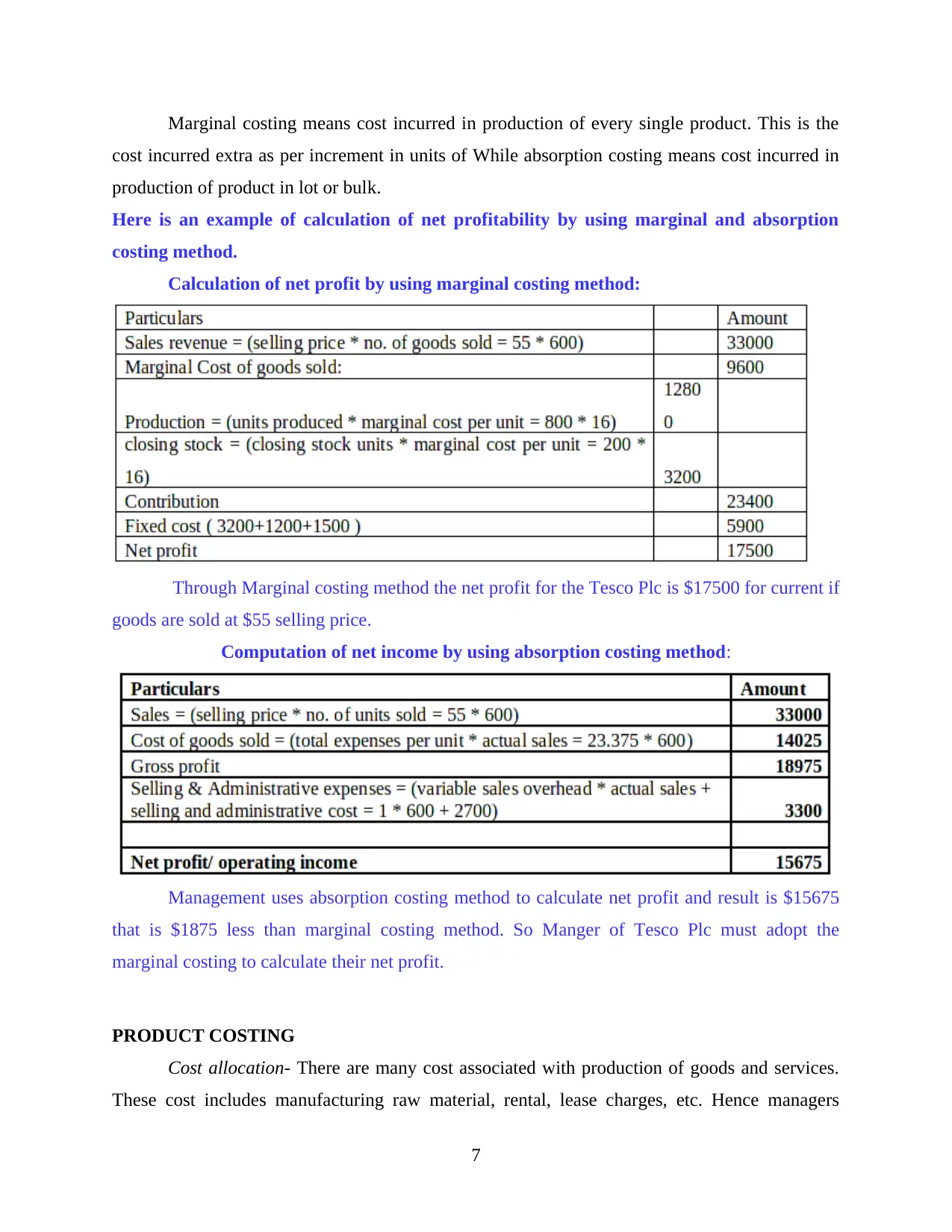
Marginal costing means cost incurred in production of every single product. This is the
cost incurred extra as per increment in units of While absorption costing means cost incurred in
production of product in lot or bulk.
Here is an example of calculation of net profitability by using marginal and absorption
costing method.
Calculation of net profit by using marginal costing method:
Through Marginal costing method the net profit for the Tesco Plc is $17500 for current if
goods are sold at $55 selling price.
Computation of net income by using absorption costing method:
Management uses absorption costing method to calculate net profit and result is $15675
that is $1875 less than marginal costing method. So Manger of Tesco Plc must adopt the
marginal costing to calculate their net profit.
PRODUCT COSTING
Cost allocation- There are many cost associated with production of goods and services.
These cost includes manufacturing raw material, rental, lease charges, etc. Hence managers
7
cost incurred extra as per increment in units of While absorption costing means cost incurred in
production of product in lot or bulk.
Here is an example of calculation of net profitability by using marginal and absorption
costing method.
Calculation of net profit by using marginal costing method:
Through Marginal costing method the net profit for the Tesco Plc is $17500 for current if
goods are sold at $55 selling price.
Computation of net income by using absorption costing method:
Management uses absorption costing method to calculate net profit and result is $15675
that is $1875 less than marginal costing method. So Manger of Tesco Plc must adopt the
marginal costing to calculate their net profit.
PRODUCT COSTING
Cost allocation- There are many cost associated with production of goods and services.
These cost includes manufacturing raw material, rental, lease charges, etc. Hence managers
7
⊘ This is a preview!⊘
Do you want full access?
Subscribe today to unlock all pages.

Trusted by 1+ million students worldwide
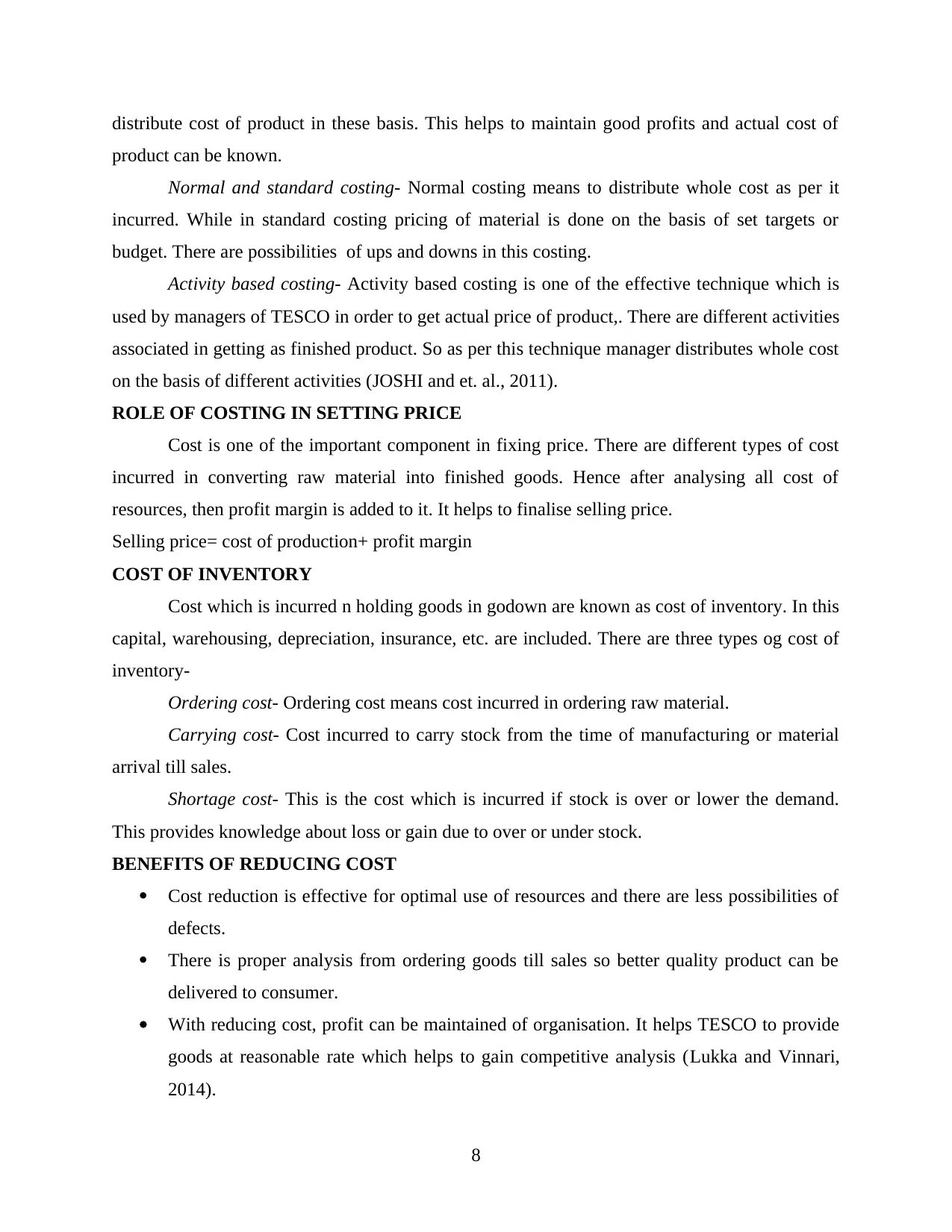
distribute cost of product in these basis. This helps to maintain good profits and actual cost of
product can be known.
Normal and standard costing- Normal costing means to distribute whole cost as per it
incurred. While in standard costing pricing of material is done on the basis of set targets or
budget. There are possibilities of ups and downs in this costing.
Activity based costing- Activity based costing is one of the effective technique which is
used by managers of TESCO in order to get actual price of product,. There are different activities
associated in getting as finished product. So as per this technique manager distributes whole cost
on the basis of different activities (JOSHI and et. al., 2011).
ROLE OF COSTING IN SETTING PRICE
Cost is one of the important component in fixing price. There are different types of cost
incurred in converting raw material into finished goods. Hence after analysing all cost of
resources, then profit margin is added to it. It helps to finalise selling price.
Selling price= cost of production+ profit margin
COST OF INVENTORY
Cost which is incurred n holding goods in godown are known as cost of inventory. In this
capital, warehousing, depreciation, insurance, etc. are included. There are three types og cost of
inventory-
Ordering cost- Ordering cost means cost incurred in ordering raw material.
Carrying cost- Cost incurred to carry stock from the time of manufacturing or material
arrival till sales.
Shortage cost- This is the cost which is incurred if stock is over or lower the demand.
This provides knowledge about loss or gain due to over or under stock.
BENEFITS OF REDUCING COST
Cost reduction is effective for optimal use of resources and there are less possibilities of
defects.
There is proper analysis from ordering goods till sales so better quality product can be
delivered to consumer.
With reducing cost, profit can be maintained of organisation. It helps TESCO to provide
goods at reasonable rate which helps to gain competitive analysis (Lukka and Vinnari,
2014).
8
product can be known.
Normal and standard costing- Normal costing means to distribute whole cost as per it
incurred. While in standard costing pricing of material is done on the basis of set targets or
budget. There are possibilities of ups and downs in this costing.
Activity based costing- Activity based costing is one of the effective technique which is
used by managers of TESCO in order to get actual price of product,. There are different activities
associated in getting as finished product. So as per this technique manager distributes whole cost
on the basis of different activities (JOSHI and et. al., 2011).
ROLE OF COSTING IN SETTING PRICE
Cost is one of the important component in fixing price. There are different types of cost
incurred in converting raw material into finished goods. Hence after analysing all cost of
resources, then profit margin is added to it. It helps to finalise selling price.
Selling price= cost of production+ profit margin
COST OF INVENTORY
Cost which is incurred n holding goods in godown are known as cost of inventory. In this
capital, warehousing, depreciation, insurance, etc. are included. There are three types og cost of
inventory-
Ordering cost- Ordering cost means cost incurred in ordering raw material.
Carrying cost- Cost incurred to carry stock from the time of manufacturing or material
arrival till sales.
Shortage cost- This is the cost which is incurred if stock is over or lower the demand.
This provides knowledge about loss or gain due to over or under stock.
BENEFITS OF REDUCING COST
Cost reduction is effective for optimal use of resources and there are less possibilities of
defects.
There is proper analysis from ordering goods till sales so better quality product can be
delivered to consumer.
With reducing cost, profit can be maintained of organisation. It helps TESCO to provide
goods at reasonable rate which helps to gain competitive analysis (Lukka and Vinnari,
2014).
8
Paraphrase This Document
Need a fresh take? Get an instant paraphrase of this document with our AI Paraphraser
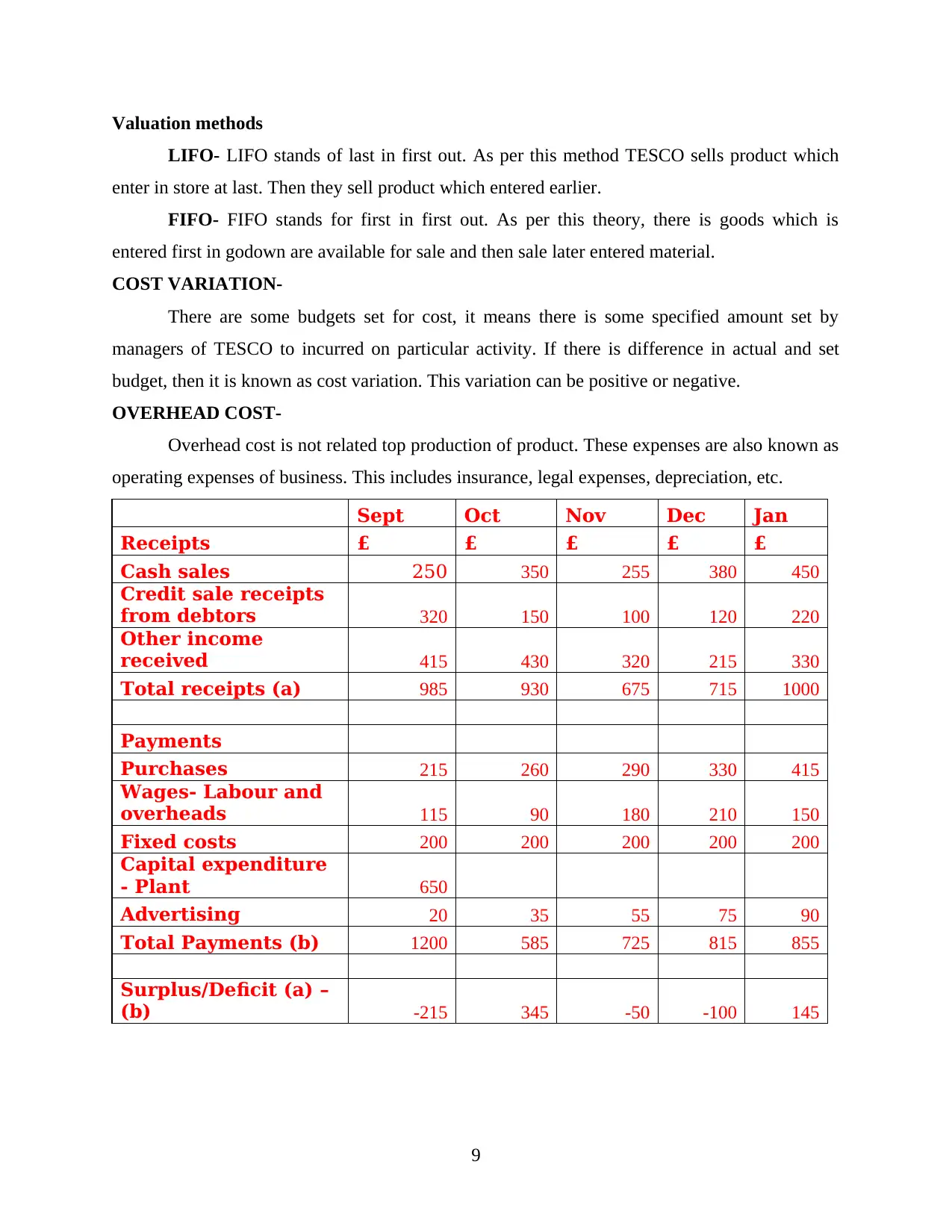
Valuation methods
LIFO- LIFO stands of last in first out. As per this method TESCO sells product which
enter in store at last. Then they sell product which entered earlier.
FIFO- FIFO stands for first in first out. As per this theory, there is goods which is
entered first in godown are available for sale and then sale later entered material.
COST VARIATION-
There are some budgets set for cost, it means there is some specified amount set by
managers of TESCO to incurred on particular activity. If there is difference in actual and set
budget, then it is known as cost variation. This variation can be positive or negative.
OVERHEAD COST-
Overhead cost is not related top production of product. These expenses are also known as
operating expenses of business. This includes insurance, legal expenses, depreciation, etc.
Sept Oct Nov Dec Jan
Receipts £ £ £ £ £
Cash sales 250 350 255 380 450
Credit sale receipts
from debtors 320 150 100 120 220
Other income
received 415 430 320 215 330
Total receipts (a) 985 930 675 715 1000
Payments
Purchases 215 260 290 330 415
Wages- Labour and
overheads 115 90 180 210 150
Fixed costs 200 200 200 200 200
Capital expenditure
- Plant 650
Advertising 20 35 55 75 90
Total Payments (b) 1200 585 725 815 855
Surplus/Deficit (a) –
(b) -215 345 -50 -100 145
9
LIFO- LIFO stands of last in first out. As per this method TESCO sells product which
enter in store at last. Then they sell product which entered earlier.
FIFO- FIFO stands for first in first out. As per this theory, there is goods which is
entered first in godown are available for sale and then sale later entered material.
COST VARIATION-
There are some budgets set for cost, it means there is some specified amount set by
managers of TESCO to incurred on particular activity. If there is difference in actual and set
budget, then it is known as cost variation. This variation can be positive or negative.
OVERHEAD COST-
Overhead cost is not related top production of product. These expenses are also known as
operating expenses of business. This includes insurance, legal expenses, depreciation, etc.
Sept Oct Nov Dec Jan
Receipts £ £ £ £ £
Cash sales 250 350 255 380 450
Credit sale receipts
from debtors 320 150 100 120 220
Other income
received 415 430 320 215 330
Total receipts (a) 985 930 675 715 1000
Payments
Purchases 215 260 290 330 415
Wages- Labour and
overheads 115 90 180 210 150
Fixed costs 200 200 200 200 200
Capital expenditure
- Plant 650
Advertising 20 35 55 75 90
Total Payments (b) 1200 585 725 815 855
Surplus/Deficit (a) –
(b) -215 345 -50 -100 145
9
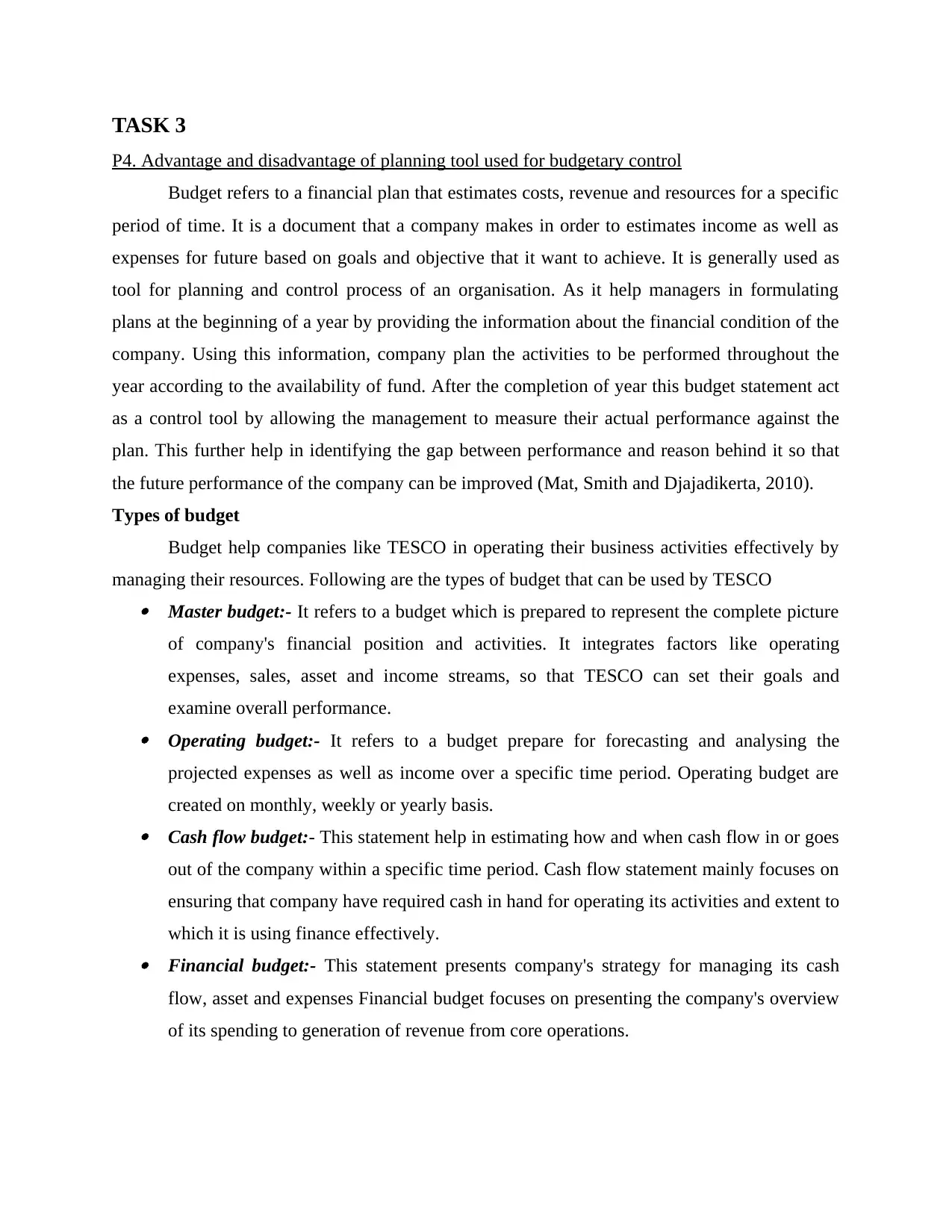
TASK 3
P4. Advantage and disadvantage of planning tool used for budgetary control
Budget refers to a financial plan that estimates costs, revenue and resources for a specific
period of time. It is a document that a company makes in order to estimates income as well as
expenses for future based on goals and objective that it want to achieve. It is generally used as
tool for planning and control process of an organisation. As it help managers in formulating
plans at the beginning of a year by providing the information about the financial condition of the
company. Using this information, company plan the activities to be performed throughout the
year according to the availability of fund. After the completion of year this budget statement act
as a control tool by allowing the management to measure their actual performance against the
plan. This further help in identifying the gap between performance and reason behind it so that
the future performance of the company can be improved (Mat, Smith and Djajadikerta, 2010).
Types of budget
Budget help companies like TESCO in operating their business activities effectively by
managing their resources. Following are the types of budget that can be used by TESCO Master budget:- It refers to a budget which is prepared to represent the complete picture
of company's financial position and activities. It integrates factors like operating
expenses, sales, asset and income streams, so that TESCO can set their goals and
examine overall performance. Operating budget:- It refers to a budget prepare for forecasting and analysing the
projected expenses as well as income over a specific time period. Operating budget are
created on monthly, weekly or yearly basis. Cash flow budget:- This statement help in estimating how and when cash flow in or goes
out of the company within a specific time period. Cash flow statement mainly focuses on
ensuring that company have required cash in hand for operating its activities and extent to
which it is using finance effectively. Financial budget:- This statement presents company's strategy for managing its cash
flow, asset and expenses Financial budget focuses on presenting the company's overview
of its spending to generation of revenue from core operations.
P4. Advantage and disadvantage of planning tool used for budgetary control
Budget refers to a financial plan that estimates costs, revenue and resources for a specific
period of time. It is a document that a company makes in order to estimates income as well as
expenses for future based on goals and objective that it want to achieve. It is generally used as
tool for planning and control process of an organisation. As it help managers in formulating
plans at the beginning of a year by providing the information about the financial condition of the
company. Using this information, company plan the activities to be performed throughout the
year according to the availability of fund. After the completion of year this budget statement act
as a control tool by allowing the management to measure their actual performance against the
plan. This further help in identifying the gap between performance and reason behind it so that
the future performance of the company can be improved (Mat, Smith and Djajadikerta, 2010).
Types of budget
Budget help companies like TESCO in operating their business activities effectively by
managing their resources. Following are the types of budget that can be used by TESCO Master budget:- It refers to a budget which is prepared to represent the complete picture
of company's financial position and activities. It integrates factors like operating
expenses, sales, asset and income streams, so that TESCO can set their goals and
examine overall performance. Operating budget:- It refers to a budget prepare for forecasting and analysing the
projected expenses as well as income over a specific time period. Operating budget are
created on monthly, weekly or yearly basis. Cash flow budget:- This statement help in estimating how and when cash flow in or goes
out of the company within a specific time period. Cash flow statement mainly focuses on
ensuring that company have required cash in hand for operating its activities and extent to
which it is using finance effectively. Financial budget:- This statement presents company's strategy for managing its cash
flow, asset and expenses Financial budget focuses on presenting the company's overview
of its spending to generation of revenue from core operations.
⊘ This is a preview!⊘
Do you want full access?
Subscribe today to unlock all pages.

Trusted by 1+ million students worldwide
1 out of 18
Related Documents
Your All-in-One AI-Powered Toolkit for Academic Success.
+13062052269
info@desklib.com
Available 24*7 on WhatsApp / Email
![[object Object]](/_next/static/media/star-bottom.7253800d.svg)
Unlock your academic potential
Copyright © 2020–2025 A2Z Services. All Rights Reserved. Developed and managed by ZUCOL.





